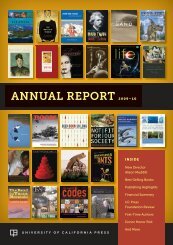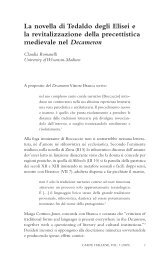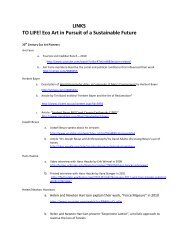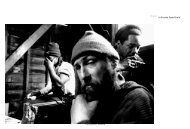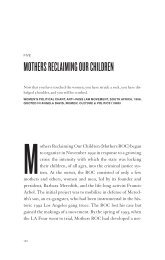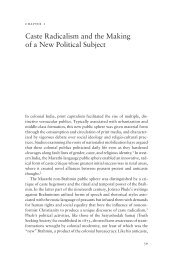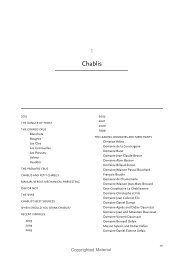Read Chapter 1 (PDF) - University of California Press
Read Chapter 1 (PDF) - University of California Press
Read Chapter 1 (PDF) - University of California Press
You also want an ePaper? Increase the reach of your titles
YUMPU automatically turns print PDFs into web optimized ePapers that Google loves.
east harlem 3<br />
block by block . . .<br />
An oversized concrete mosque dominates the corner <strong>of</strong> 96th Street and<br />
Third Avenue. Still unfinished but obviously thriving, the mosque is one<br />
<strong>of</strong> several institutions that mark the physical boundaries <strong>of</strong> the neighborhood.<br />
A few blocks away, between Second and First Avenues, stands<br />
Metropolitan Hospital, a large public institution that serves the majority<br />
<strong>of</strong> residents who have little or no health care coverage. On the opposite<br />
border, nestled in the most affluent corner <strong>of</strong> East Harlem on Fifth<br />
Avenue, lies Mt. Sinai Hospital. Mt. Sinai is an even larger voluntary hospital,<br />
serving the well-to-do <strong>of</strong> the Upper East Side and the few well<br />
insured <strong>of</strong> East Harlem. These buildings at the southern border <strong>of</strong> East<br />
Harlem mark <strong>of</strong>f the barrio and stand out from the largely undifferentiated<br />
low-slung buildings <strong>of</strong> the neighborhood.<br />
Standing next to the mosque, at the top <strong>of</strong> the hill on 96th Street that<br />
descends down into East Harlem, you can tell it’s Friday by the black Lincoln<br />
Town Cars triple-parked along Third Avenue. The cars, lined up like<br />
a UN motorcade or a dignitary’s funeral procession, wait for their owners<br />
to finish their afternoon prayers. They are the “gypsy cabs” that serve<br />
East Harlem and neighborhoods like it. The ubiquitous yellow taxis <strong>of</strong><br />
Manhattan rarely cross the border at 96th Street without a paying customer<br />
already inside, usually headed for La Guardia Airport via the Triboro<br />
Bridge at 125th Street and First Avenue. Instead, the streets <strong>of</strong> East<br />
Harlem teem with the dark sedans <strong>of</strong> gypsy cab drivers, tapping their<br />
horns at each intersection to interest potential customers. The gypsy cabs<br />
are driven mostly by entrepreneurial West Africans who have managed<br />
to save enough cash to buy a car and work as illicit “wholesale” vendors<br />
on the streets. They <strong>of</strong>fer reliable car service to local residents based on<br />
negotiated rates. With no meters and little regulation, the gypsy cabs are<br />
as illegal as street vendors, but the city has long abdicated control over<br />
this niche <strong>of</strong> the informal economy.<br />
North along Third Avenue, past the mosque and Metropolitan Hospital,<br />
the street level is dominated by the thriving commerce <strong>of</strong> 99-cent<br />
stores, corner bodegas, discount clothing stores, and fast-food restau-



